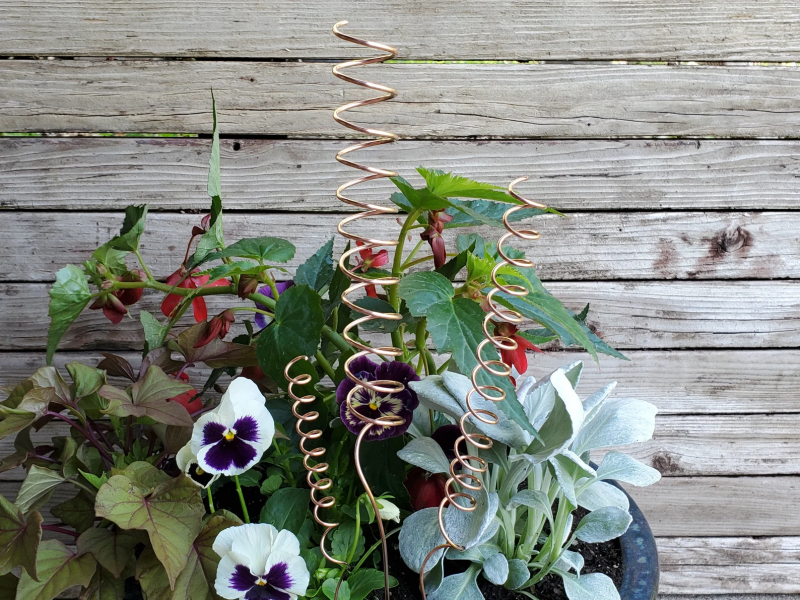電気栽培アンテナ、または電磁アンテナとも呼ばれるものは、電気栽培の実践に使用される装置であり、電磁場を活用して植物の成長を促進し、農業の成果を向上させるために利用されます。
これらのアンテナは、電磁波や電磁場を捕捉し、植物と周囲の環境との相互作用をもたらします。放射される電磁エネルギーは、植物内のさまざまな生物学的プロセスを刺激し、成長の促進、栄養の吸収の改善、総合的な活力の向上につながると考えられています。
電気栽培アンテナが放射する特定の周波数や波長は、効果の目的や栽培される植物の種によって異なる場合があります。一部のアンテナは低周波の電磁場を放射し、他のものはより高い周波数を利用します。これらの電磁場は、植物の自然な電磁周波数と共鳴し、植物と環境の間のコミュニケーションやエネルギー伝達を円滑化する役割を果たすと考えられています。
電気栽培アンテナで使用される周波数は、時にシューマン共鳴と関連付けられることがあります。シューマン共鳴とは、主に雷放電によって引き起こされる地球の大気中の電磁波の一連の周波数です。これらの共鳴周波数は、おおよそ7.83 Hzから33.8 Hzまでの範囲にあり、基本周波数は約7.83 Hzです。
電気栽培の支持者の一部は、シューマン共鳴の範囲内または近くの周波数を利用することが植物の成長に良い影響を与えると考えています。彼らは、植物がこれらの自然な周波数と調和して進化してきた可能性があり、それらに共鳴する電磁場に好意的に反応する可能性があると示唆しています。
ただし、電気栽培アンテナの周波数とシューマン共鳴との関係は、一般的に合意されているわけではなく、完全に理解されているわけではありません。一部の実践者や研究者は、両者の間に関連性を見出していますが、シューマン共鳴が植物の成長に直接的な影響を与えるか、アンテナの周波数をこれらの共鳴に合わせることの有効性についての科学的な合意や経験的な証拠は、現在も研究が続けられている課題です。
電気栽培の支持者は、これらのアンテナの使用により多くの利益がもたらされると主張しています。これには、種子の発芽の促進、より大きく健康な植物、収量の増加、病気や害虫への抵抗力の向上、土壌の品質の向上などが含まれます。また、電気栽培アンテナは、干ばつや極端な温度などの環境ストレスの負の影響を軽減するのに役立つとされており、より良い植物の回復力と適応性を促進します。
電気栽培アンテナの効果と科学的な基盤は、まだ議論の対象であり、継続的な研究が行われています。一部の研究や経験的な証拠は、その潜在的な利益を支持していますが、その作用機序を完全に理解し、さまざまな農業の状況での最適な活用方法を確立するためには、さらなる調査が必要です。
農業技術として、電気栽培アンテナに対しては柔軟な考え方で接し、徹底的な実験を行い、ホリスティックで持続可能な農業手法に組み込むことをお勧めします。現在のところ、従来の科学は電気栽培が植物の成長に与える効果についての説明を持っていません。そのため、電気栽培の将来的な発展のためには、継続的な実験と研究の共有が重要です。
電気栽培や関連する分野が進展し続ける中、異なる周波数の具体的な効果や植物、土壌、その他の環境要因との相互作用を探るためにさらなる研究が必要とされています。これは、現在も研究と議論が続く領域です。
Electro-culture antennas, also known as electromagnetic antennas, are devices used in the practice of electro-culture, which involves utilizing electromagnetic fields to enhance plant growth and improve agricultural outcomes.
These antennas are designed to capture and transmit electromagnetic waves or fields, which interact with plants and the surrounding environment. The emitted electromagnetic energy is believed to stimulate various biological processes within plants, leading to increased growth, improved nutrient uptake, and enhanced overall vitality.
The specific frequencies and wavelengths emitted by electro-culture antennas can vary depending on the desired effects and plant species being cultivated. Some antennas emit low-frequency electromagnetic fields, while others utilize higher frequencies. These electromagnetic fields are thought to resonate with the natural electromagnetic frequencies of plants, facilitating better communication and energy transfer between plants and their environment.
The frequencies used in electro-culture antennas are sometimes associated with the Schumann resonances. The Schumann resonances are a set of electromagnetic frequencies in the Earth’s atmosphere, primarily caused by lightning discharges. These resonant frequencies range from approximately 7.83 Hz to 33.8 Hz, with the fundamental frequency at around 7.83 Hz.
Some proponents of electro-culture believe that utilizing frequencies within or near the range of the Schumann resonances can have positive effects on plant growth. They suggest that plants have evolved in harmony with these natural frequencies and may respond favorably to electromagnetic fields that resonate with them.
However, it’s important to note that the relationship between electro-culture antenna frequencies and the Schumann resonances is not universally agreed upon or fully understood. While some practitioners and researchers draw connections between the two, the scientific consensus and empirical evidence regarding the direct influence of Schumann resonances on plant growth and the efficacy of matching antenna frequencies to these resonances remain subjects of ongoing investigation.
Advocates of electro-culture claim that the use of these antennas can result in numerous benefits. These may include accelerated seed germination, larger and healthier plants, increased crop yields, improved resistance to diseases and pests, and enhanced soil quality. It is also suggested that electro-culture antennas can help mitigate the negative effects of environmental stressors, such as drought or extreme temperatures, by promoting better plant resilience and adaptability.
It’s important to note that the effectiveness and scientific basis of electro-culture antennas are still subjects of debate and ongoing research. While some studies and anecdotal evidence support their potential benefits, further investigation is needed to fully understand their mechanisms of action and optimize their application in various agricultural contexts.
As with any agricultural technique, it is recommended to approach electro-culture antennas with an open mind, conduct thorough experimentation, and consider integrating them into a holistic and sustainable farming approach. Conventional science so far does not have an explanation for the effects that electro culture antennas have on plant growth, therefore continued experimentation and sharing of research is vital for the future developments of electro culture
As electro-culture and related fields continue to evolve, further research is needed to explore the specific effects of different frequencies and their interactions with plants, soil, and other environmental factors. It is an area of ongoing scientific exploration and debate
